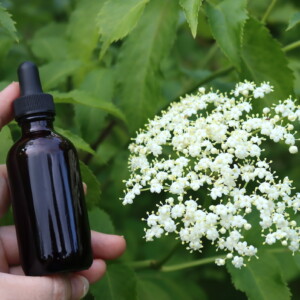
Elderflower Tincture
Elderflower tincture is a gentle remedy for colds, flu, and other minor illnesses.
Equipment
Ingredients
- Fresh or dried elderflowers from the Sambucus nigra plant
- High-proof alcohol vodka, brandy, or rum, 60 proof or higher
Instructions
- Harvest fresh elderflowers when they are in full bloom. Gather enough to fill your mason jar about halfway. If you’re using dried elderflowers, aim to fill your jar about 1/3 to 1/2 full. Gently shake or rinse the flowers to remove any dirt or bugs. For fresh flowers, avoid packing them too tightly as they contain moisture and will settle once submerged in alcohol.
- Place the elderflowers into your clean jar, making sure they are well-covered. Pour your high-proof alcohol (vodka is most common, though brandy or rum work well) over the flowers until they are completely submerged. The alcohol level should be about an inch or two above the plant material to ensure full immersion.
- Close the jar tightly with its lid and give it a good shake. This helps to mix the herbs and alcohol and ensures the plant material is fully soaked. Store the jar in a cool, dark place, like a cupboard or pantry, and allow the herbs to infuse for 4 to 6 weeks.
- During the infusion period, shake the jar gently every few days. This helps to keep the plant material submerged and encourages the alcohol to extract the beneficial compounds from the flowers.
- After 4 to 6 weeks, it’s time to strain the tincture. Place a cheesecloth or fine mesh strainer over a clean bowl or jar, and pour the tincture through it to separate the liquid from the plant material. Press on the flowers to extract as much of the liquid as possible.
- Once strained, pour the tincture into dark glass storage bottles to protect it from light, which can degrade its potency. Be sure to label your tincture with the date, ingredients, and dosage information. Store it in a cool, dark place, where it should remain potent for several years.
Notes
Vodka is often used for tinctures because it has a neutral flavor, but brandy or rum can add a unique depth to the tincture’s flavor profile. Just ensure the alcohol is 60 proof or higher to preserve the tincture.
Elderflowers are particularly delicious when infused into alcohol, and many people make elderflower liqueur just for its taste rather than its medicinal benefits. I like to make it with a very neutral vodka, that’s mid-shelf or better, which makes it a delight to take.
Usage and Dosage
Elderflower tincture is commonly used for its immune-boosting and anti-inflammatory properties. It can help ease the symptoms of colds, flu, allergies, and congestion. It is also traditionally used for its calming effects, helping to reduce anxiety and promote restful sleep. Typical Dosage: The usual dosage for elderflower tincture is 1 to 2 teaspoons, 2 to 3 times per day. You can take it directly, or dilute it in a small amount of water or tea. For Respiratory Health: Elderflower tincture is often used to help relieve symptoms of colds, coughs, and sinus congestion. Its diaphoretic properties can help promote sweating to reduce fever and ease discomfort. For Relaxation: A few drops before bedtime can help calm the nerves and promote sleep, especially if you are dealing with stress or anxiety.Alcohol-Free Glycerite Option
For those who prefer to avoid alcohol, you can make an alcohol-free glycerite tincture using vegetable glycerin. To do this, use a 3:1 ratio of glycerin to distilled water for dried elderflowers. If you are using fresh elderflowers, use 100% vegetable glycerin and skip the water. Follow the same basic procedure: fill the jar with your plant material, cover it with the glycerin mixture, and let it steep for 4 to 6 weeks, shaking it daily. Once done, strain and transfer to a dark storage bottle.Yield and Storage
The amount of tincture you yield will depend on how much elderflower you use, and how tightly you pack the jar. For fresh flowers, you can expect to end up with slightly more tincture than the alcohol you started with due to the moisture content of the flowers. With dried flowers, you may get slightly less than the alcohol volume, as the flowers absorb some of the liquid during infusion. You will need about 2 to 3 cups of alcohol for a quart-sized jar, or 1 to 1.5 cups for a pint jar. Be sure the plant material stays submerged throughout the process to ensure optimal extraction. Tried this recipe?Let us know how it was!